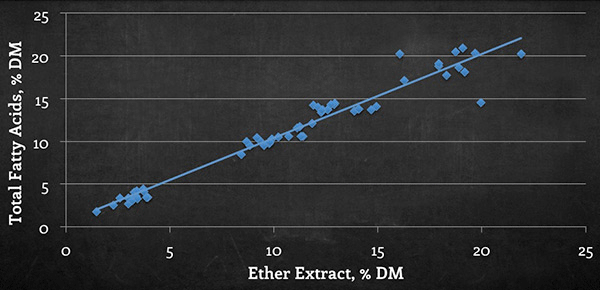
Big Fat Idea #2: The Truth About Ether Extract
Dr. Adam Lock Michigan State University
 Truth be told, for concentrates there is a good correlation between the less expensive and quicker ether extract analysis compared with total fatty acid concentration, thus making it particularly useful for monitoring variability of batches of byproducts. This does not hold true for forages since often fatty acids are only 50% of ether extract in that case.
Truth be told, for concentrates there is a good correlation between the less expensive and quicker ether extract analysis compared with total fatty acid concentration, thus making it particularly useful for monitoring variability of batches of byproducts. This does not hold true for forages since often fatty acids are only 50% of ether extract in that case. The Bottom Line:
Stick to using ether extract for byproducts, rather than forages, as a measure of fatty acid concentration and consider it a simple, inexpensive tool to monitor variability of these feedstuffs.
Ether Extract vs. Total Fatty Acid Analysis
(Canola, Cottonseed & DDGs)


Dr. Adam Lock Michigan State University
Dr. Adam Lock of Michigan State University joined The Fatty Acid forum to discuss feed lipid variation and its impact on cow performance. Dr. Lock covered the considerable variation of the fatty acid content and composition of fermented feeds, grains, pasture, and byproducts; why variation in fatty acid content may be important to diet formulation, intake of fatty acids, and risk of milk fat depression; and possible effects of free vs. esterified fatty acids in feeds and the impact(s) on rumen function and animal production.
05.20.2013